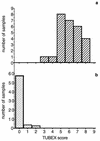One-step 2-minute test to detect typhoid-specific antibodies based on particle separation in tubes
- PMID: 9666004
- PMCID: PMC105030
- DOI: 10.1128/JCM.36.8.2271-2278.1998
One-step 2-minute test to detect typhoid-specific antibodies based on particle separation in tubes
Abstract
Typhoid fever is caused by Salmonella typhi. Detection of anti-S. typhi antibodies in the patient is a useful diagnostic aid. Among the various methods developed over the years for this purpose, the Widal test, based on bacterial agglutination, has remained the most widely used, even though it is neither specific nor sensitive. Its popularity stems from the fact that it is simple to use and inexpensive. We describe a new test which also uses a simple one-step procedure but is more rapid and accurate than the Widal. The new test (TUBEX) detects anti-Salmonella O9 (both immunoglobulin M [IgM] and IgG) antibodies in patients by inhibiting the binding between an anti-O9 IgM monoclonal antibody (MAb) conjugated to colored latex particles and S. typhi lipopolysaccharide (LPS) conjugated to magnetic latex particles. The reactants are mixed in a specially designed microtube for 2 min, and the result is read based on the resultant color of the supernatant following forced sedimentation of the magnetic beads. In the absence of inhibitory antibodies, there is a color change (from blue to red) due to cosedimentation of the indicator particles with the magnetic particles, whereas if these antibodies are present, they prevent such a change to a degree dependent on their concentration. Preliminary examination of TUBEX using the anti-O9 MAb and irrelevant MAbs as inhibitors revealed the test to be specific and reproducible, with an analytical sensitivity of 16 micrograms per ml of antibody. The reagents remained stable for at least 9 months when kept at 4 degrees C. In the examination of 16 stored sera obtained from 14 patients with proven cases of typhoid fever and 78 serum samples from 75 subjects without typhoid fever, TUBEX was found to be 100% sensitive and 100% specific. The nontyphoid group comprised 26 healthy blood donors, 30 antinuclear antibody (ANA)-negative patients, 9 ANA-positive patients, of whom 1 was positive for anti-DNA antibody, 4 typhus patients, and 6 septicemic patients. In addition, the sera obtained from 11 patients clinically diagnosed as having typhoid fever were all positive in the test. The TUBEX results correlated to some extent, albeit insignificantly (r = 0.38, P = 0.07), with those of an enzyme-linked immunoassay (ELISA) which used a similar detection format (inhibition) and reagents (S. typhi LPS and anti-O9 antibody). TUBEX correlated very well with ELISAs which detected anti-S. typhi LPS IgM (r = 0.58, P = 0.003) or IgG (r = 0.54, P = 0.006) antibodies from the typhoid patients. There was no correlation with the Widal test. The TUBEX test, if performed on slides (instead of tubes) or with soluble antigen (instead of antigen-conjugated magnetic beads), suffered significantly in sensitivity. Direct agglutination tests using LPS-conjugated indicator particles performed either on slides or in microwells also failed to detect antibodies from the majority of typhoid patients. Thus, TUBEX appears to be well designed and well suited for use in the laboratory or by the bedside as a simple, rapid aid to the routine diagnosis of typhoid fever.
Figures





References
-
- Cheong Y M, Jegathesan M. Standardisation of the Widal test. Med J Malays. 1989;44:267. - PubMed
-
- Choo K E, Oppenheimer S J, Ismail A B, Ong K H. Rapid serodiagnosis of typhoid fever by dot enzyme immunoassay in an endemic area. Clin Infect Dis. 1994;19:172–176. - PubMed
-
- Choy W F, Ng M H, Lim P L. Trichinella spiralis: light microscope monoclonal antibody localization and immunochemical characterization of phosphorylcholine and other antigens in the muscle larva. Exp Parasitol. 1991;73:172–183. - PubMed
-
- Hudson L, Hay F C. Practical immunology. 3rd ed. Oxford, United Kingdom: Blackwell Scientific Publications; 1989.
Publication types
MeSH terms
Substances
LinkOut - more resources
Full Text Sources
Other Literature Sources

